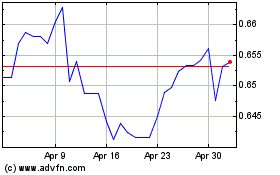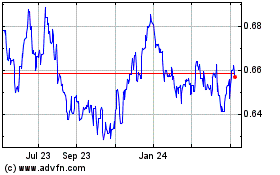Commodity currencies such as the Australian, the New Zealand and
the Canadian dollars retreated from recent highs against their
major counterparts in the Asian session on Wednesday, after data
showed China's industrial output fell more than expected in
September.
Data from the National Bureau of Statistics showed that the
China's annual growth in industrial production eased unexpectedly
to 6.1 percent in September from 6.3 percent in August. Output was
expected to expand 6.4 percent.
Meanwhile, China's gross domestic product expanded 6.7 percent
in the third quarter, the same pace of growth as seen in the first
and second quarters. The annual growth also came in line with
economists' expectations.
The 6.7 percent expansion also remains well within the economic
planners' full-year growth target of 6.5-7 percent. In 2015, the
economy grew at the slowest pace in 25 years.
On a sequential basis, the economy expanded 1.8 percent as
expected in the third quarter.
The retail sales grew at a slightly faster pace of 10.7 percent,
in line with expectations, after expanding 10.6 percent in
August.
Fixed asset investment climbed 8.2 percent in the first nine
months of 2016 versus 8.1 percent increase registered during
January to August.
Ahead of the china data, the commodity currencies rose against
its major rivals amid risk appetite, as crude oil prices edged
higher in Asian trades. The crude oil price rose following
headlines from a key oil and gas conference attended by OPEC's
secretary general.
Mohammed Barkindo, secretary general of the Organization of the
Petroleum Exporting Countries, expressed confidence that Russia and
certain OPEC members will curb production in order to stabilize oil
markets.
A report from the American Petroleum Institute or API, showed
that the U.S. crude stockpiles fell 3.8 million barrels in the week
to Oct. 14, to 467.1 million barrels. Traders also await the U.S.
Energy Information Administration or EIA to release its official
crude oil inventories data, due later on the day.
Tuesday, the Australian, the New Zealand and the Canadian
dollars rose against their major rivals.
The Australian dollar rose 0.78 percent against the U.S. dollar,
0.62 percent against the yen, and 0.67 percent against the euro.
The New Zealand dollar rose 1.07 percent against the U.S. dollar,
0.87 percent against the yen and 0.93 percent against the euro. The
Canadian dollar rose 0.14 percent against the U.S. dollar, 0.21
percent against the yen, and 0.31 percent against the euro.
In the Asian trading, the Australian dollar fell to 1.4342
against the euro from an early near 1-1/2-year high of 1.4290. The
aussie may test support near the 1.46 region.
Against the U.S. dollar, the aussie dropped to 0.7661 from an
early more than a 2-week high of 0.7690. On the upside, 0.75 is
seen as the next support level for the aussie.
Against the yen, the New Zealand and the Canadian dollars, the
aussie edged down to 79.54, 1.0625 and 1.0064 from early highs of
79.83, 1.0658 and 1.0064, respectively. If the aussie extends its
downtrend, it is likely to find support around 77.00 against the
yen, 1.04 against the kiwi, and 0.99 against the loonie.
The NZ dollar fell to 0.7204 against the U.S. dollar and 74.79
against the yen, from an early more than 2-week high of 0.7235 and
more than a 1-month high of 75.06, respectively. If the kiwi
extends its downtrend, it is likely to find support around 0.71
against the greenback and 73.00 against the yen.
Against the euro, the kiwi dropped to 1.5251 from an early near
4-week high of 1.5192. The kiwi is likely to find support near the
1.55 region.
The Canadian dollar fell to 1.3107 against the U.S. dollar and
79.19 against the yen, from early highs of 1.3083 and 79.34,
respectively. If the loonie extends its downtrend, it is likely to
find support around 1.33 against the greenback and 77.00 against
the yen.
Against the euro, the loonie dropped to 1.4404 from an early
high of 1.4378. On the downside, 1.46 is seen as the next support
level for the loonie.
Looking ahead, U.K. jobs data and Eurozone construction output,
both for August, are due to be released later in the day.
In the New York session, U.S. housing starts and building
permits, both for September, and U.S. crude oil inventories data
are slated for release.
At 8:45 am ET, Federal Reserve Bank of San Francisco President
John Williams is expected to speak before the "Improving Diversity
in the Financial Services Industry - An Holistic View" conference
hosted by the Global Interdependence Center, in New Jersey.
At 9:15 am ET, U.K. Finance minister Philip Hammond is sheduled
to deliver a speech in parliament, in London.
At 9:30 am ET, European Parliament's Brexit negotiator Guy
Verhofstadt is expected to speak at conference on "Future of EU
budget, reform of EU institutional set-up" in Brussels.
The Bank of Canada's interest rate decision is due at 10:00 am
ET .The economists expect the bank to hold rates at 0.50
percent
Subsequently, the Bank of Canada Governor Stephen Poloz and
Senior Deputy Governor Carolyn Wilkins will hold a press conference
following the bank's interest rate decision and release of its
monetary policy report at 11:00 am ET in Ottawa.
At 1:00 pm ET, Bank of England Chief Economist Andy Haldane is
expected to speak on "QE - The story so far" at Cass Business
School, in London.
At 1:30 pm ET, European Central Bank board member Daniele Nouy
is expected to speak at the European Financial Roundtable organised
by Deutsche Bank in Frankfurt.
At 2:00 pm ET, Federal Reserve issues the Beige Book of economic
condition in Washington.
At 4:15 pm ET, Bank of Canada Governor Stephen Poloz and Senior
Deputy Governor Carolyn Wilkins will testify before the Senate
Standing Committee on Banking, Trade, and Commerce, in Ottawa.
AUD vs US Dollar (FX:AUDUSD)
Forex Chart
From Mar 2024 to Apr 2024

AUD vs US Dollar (FX:AUDUSD)
Forex Chart
From Apr 2023 to Apr 2024
